#gray's beaked whale
Explore tagged Tumblr posts
Text
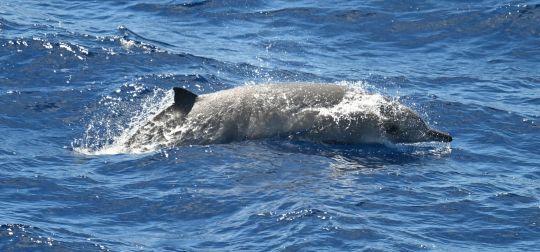
Gray's beaked whale Mesoplodon grayi
Observed by afahawkins, CC BY-NC
37 notes
·
View notes
Text
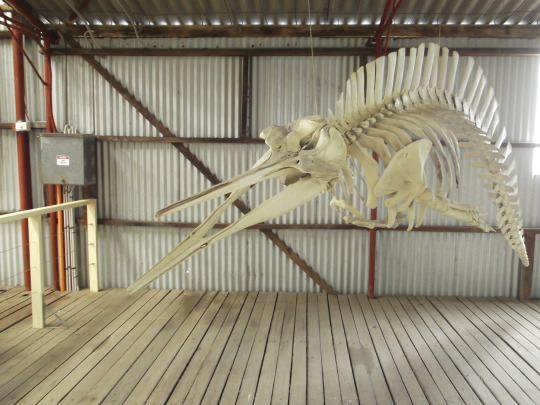

#from a few weeks ago#skeleton#gray's beaked whale#false killer whale#skeletons#myphoto#whale#cetacean
7 notes
·
View notes
Text


1 note
·
View note
Text
My etsy shop is open again!
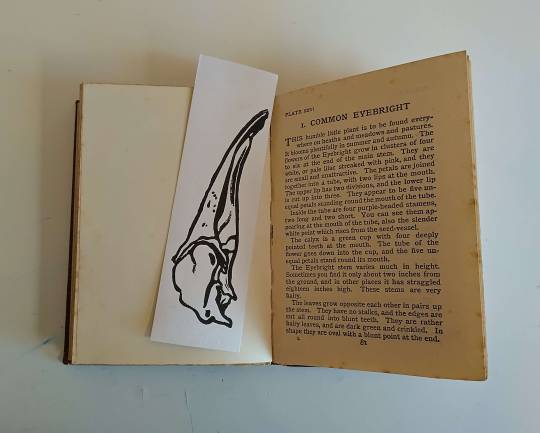

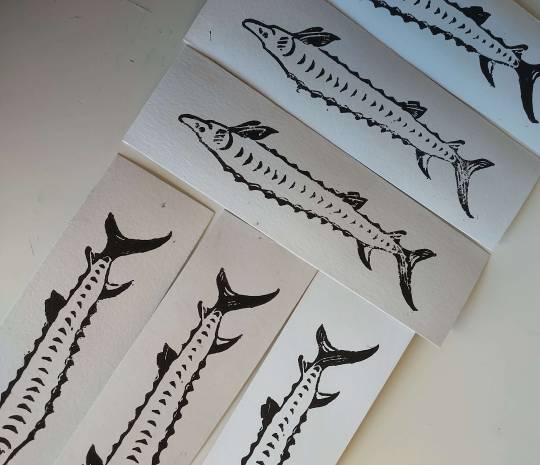

[ID: four photos of handmade linoprint bookmarks in two designs: sturgeon and grays beaked whale skulls. they are printed in black ink, and have text from hamlet on the back. one photo shows one of the bookmarks in an old book. end ID]
I added these bookmarks, and plan on adding more patches too. I also have cards, linoprints, stickers, and space dog patches 🚀🐶
#i have written this post three times now. tumblr pls cooperate#etsyseller#etsyshop#etsystore#etsyfinds#artists on etsy#handmade#bookmarks#sturgeon#grays beaked whale#beaked whale#linoprint#linocut#handprinted
11 notes
·
View notes
Text
Round 3 - Mammalia - Artiodactyla




(Sources - 1, 2, 3, 4)
Our final order of mammals, and second order of ungulates is Artiodactyla, commonly referred to as “even-toed ungulates”. Artiodactyla is a large and highly diverse group which includes the living families Camelidae (“camels”, “vicuñas”, “guanacos”, and kin), Suidae (“pigs”), Tayassuidae (“peccaries”), Hippopotamidae (“hippopotamuses”), Balaenidae (“right whales” and “Bowhead Whale”), Cetotheriidae (“Pygmy Right Whale”), Balaenopteridae (“rorquals”), Eschrichtiidae (“Gray Whale”), Delphinidae (“oceanic dolphins”), Monodontidae (“Beluga Whale” and “Narwhal”), Phocoenidae (“porpoises”), Kogiidae (“Pygmy and Dwarf Sperm Whales”), Physeteridae (“Sperm Whale”), Iniidae (“South American river dolphins”), Platanistidae (“south Asian river dolphins”), Pontoporiidae (“La Plata Dolphin”), Ziphiidae (“beaked whales”), Tragulidae (“chevrotains”), Antilocapridae (“Pronghorn”), Giraffidae (“giraffes” and “Okapi”), Cervidae (“deer”), Moschidae (“musk deer”), and Bovidae (“cattle”, “antelopes”, “goats”, and kin).
Artiodactyls are typically defined by the fact that they bear most of their weight equally on two or four of the five original ungulate toes. However, all living members of the infraorder Cetacea have lost their toes, replacing them with flipper-like limbs. Many artiodactyls have a relatively large head, with an elongated and narrow skull. Some families have cranial appendages, which include true horns, antlers, ossicones, or pronghorns. True horns have a bone core that is covered in a permanent sheath of keratin, and are found only in the Bovids. Antlers are bony structures that are shed and replaced each year, only found in deer. Artiodactyls have a well-developed sense of smell and sense of hearing. Similar to many other prey animals, their eyes are on the sides of the head, giving them an almost panoramic view, so that they can keep an eye out for predators while grazing. This order is highly diverse, ranging in size from the rabbit-sized Java Mouse-deer (Tragulus javanicus) to the largest mammal, and possibly the largest animal to ever exist: the Blue Whale (Balaenoptera musculus). Most are herbivorous, but many are omnivores or even carnivores.
Male artiodactyls are usually larger than females. In the majority of deer species, only the males grow antlers, and the horns of female bovines are usually smaller or absent. As this is a very diverse group, social and mating behavior vary between species. They have a tendency to form larger groups, but some live alone or in pairs. Species living in groups often have a hierarchy, both among males and females. Some species also live in harem groups, with one male, several females, and their common offspring. In other species, the females and juveniles stay together, while males are solitary or live in bachelor groups and seek out females only during mating season. Generally, artiodactyls tend to have long gestation periods, smaller litter sizes, and more highly-developed young (usually called a “calf”). Most deliver 1 or 2 calves at a time, but some pigs can deliver up to ten. Newborn artiodactyls are precocial and are born with hair and open eyes.
The oldest fossils of artiodactyls date back to the early Eocene (about 53 million years ago).

Propaganda under the cut:
More than half the species in the family Camelidae are domesticated, with the only living wild camelids being the Vicuña (Lama vicugna) (ancestor of the domestic Alpaca), the Guanaco (Lama guanicoe) (ancestor of the domestic Llama), and the Wild Bactrian Camel (Camelus ferus) (NOT the ancestor of the Domestic Bactrian).
Camelids have true canine teeth and tusk-like premolars, which are separated from the molars by a gap.
Both the Bactrian Camel (Camelus bactrianus) (image 1) and the Dromedary (Camelus dromedarius) were domesticated in ancient times for riding, transport, ploughing, and as a source of milk, meat, wool, and leather. Today, the wild ancestors of both of these species are extinct, and only feral populations of domestic camels remain. The only truly wild camel species left is the Wild Bactrian Camel (Camelus ferus), which is critically endangered.
The Wild Bactrian Camel can survive on water saltier than seawater, something which no other mammal in the world seems to be able to tolerate, including the domestic Bactrian Camel.
In Aymara mythology, Llamas (Lama glama) are sacred beings. The Heavenly Llama is said to drink water from the ocean and urinates as it rains. According to Aymara eschatology, llamas will return to the water springs and ponds where they come from at the end of time.
Babirusas (genus Babyrousa) are unique for their prominent, upwards incurving, canine tusks, which pierce out through the flesh of the snout in males. The upper canine tusks continue growing, curving backward over the front of the face and towards the forehead. If a male Babirusa does not grind his tusks (achievable through regular activity), they can eventually keep growing and, rarely, even penetrate the individual's skull.
The Domestic Pig (Sus domesticus) was domesticated from the Wild Boar (Sus scrofa) beginning in the Neolithic, and is a result of two different domestication events in both the Middle East and China. They are mostly kept for meat and leather, but are also used in medicine and as pets. The Domestic Pig is one of the few omnivorous animals to be domesticated.
The endangered Chacoan Peccary (Catagonus wagneri) is the rarest of the 3 living species of peccary, with only around 3,000 individuals left in the world. It is a “Lazarus taxon”, as its genus was first described from fossil remains of the extinct Catagonus metropolitanus. The Chacoan Peccary only lives in hot, dry, thorny areas of the Gran Chaco.
While the semi-aquatic hippopotamuses were once more diverse, only two species of different branching lineages remain: the vulnerable Common Hippopotamus (Hippopotamus amphibius) (see gif above) and the endangered Pygmy Hippopotamus (Choeropsis liberiensis).
The Egyptian goddess Tawaret is depicted as a pregnant woman with a hippopotamus head, representing fierce maternal love.
Humans have hunted whales since prehistoric times, with depictions of whaling dating back to 6000 BC. Whales are hunted for their meat, blubber, and oil. Whale oil was in high demand for lighting lamps in the 18th century. The Sperm Whale (Physeter macrocephalus) was particularly prized for spermaceti, a dense waxy substance that burns with an exceedingly bright flame that is found in the whale’s spermaceti organ. Approximately 40% of Right Whales' (genus Eubalaena) (image 3) body mass is blubber, and thus they were known as the "right" whale to kill. Today, the North Atlantic Right Whale (Eubalaena glacialis) is the most critically endangered great whale, with around 372 individuals left in the world. While whale hunting has been significantly curtailed in recent years, whales still face threats from entanglement in fishing gear, boat strikes, underwater noise pollution, plastic and heavy metals build-up, and accelerating climate change. Cetaceans are still hunted in some countries.
The Humpback Whale (Megaptera novaeangliae) is known to not only fight back against their main predators, Orcas (Orcinus orca), but also to interfere with Orca hunting parties, rescuing their prey.
The mysterious Narwhal (Monodon monoceros) is known for the long tusk of the males, which is a protruding left canine thought to function as a weapon, a tool for feeding, in attracting mates, or for sensing water salinity. Some males may grow two tusks, occurring when the right canine also protrudes through the lip. Some females may grow a tusk as well, but it is usually smaller than the tusks of males.
The critically endangered Vaquita (Phocoena sinus) is the smallest of all living cetaceans, reaching a maximum body length of 150 cm (4.9 ft) for females or 140 cm (4.6 ft) for males. The Vaquita is one of the most endangered animals in the world, with around 6-11 individuals remaining. They are endangered primarily due to bycatch in gillnets from the illegal Totoaba (Totoaba macdonaldi) fishery.
The Baiji (Lipotes vexillifer) was a river dolphin, and the last surviving member of the family Lipotidae. It is classified as "critically endangered: possibly extinct", as no specimens have been seen in the Yangtze River in over 20 years. Heavy use of the river for fishing, transportation, and hydroelectricity were the likely causes of this unique species’ extinction. While some individuals may survive, their population is likely too low to recover. If indeed extinct, the Baiji's disappearance would be the first recorded extinction of a well-studied cetacean species to be directly attributable to human influence.
The Pronghorn (Antilocapra americana) is the last surviving member of its family. While they are sometimes referred to as antelope, this is an example of convergent evolution, and their closest living relatives are the Giraffids. The Pronghorn is the fastest land mammal in the Americas, and the third fastest land mammal on Earth, with running speeds of up to 88.5 km/h (55 mph). This running speed was likely an adaptation to flee the Pleistocene American Cheetahs (genus Miracinonyx), which are now extinct.
Giraffes are the tallest living land animals, with the largest being the Masai Giraffe (Giraffa tippelskirchi). Bull Masai Giraffes can grow up to 5.5 meters (18 feet) in height, and weigh 1,300 kilograms (2,900 pounds).
Caribou (Rangifer tarandus), also known as Reindeer, are unique among Cervids in that females may have antlers, although the prevalence of antlered females varies by subspecies.
Cervid antlers are a controlled form of bone cancer. Antler growth is tightly regulated by the activity of tumor-suppressing and tumor-growth-inhibiting genes. The cancer-suppressing genes that keep growth in check also protect against cancer in general, and documented cancer rates in deer that are five times lower than rates in other mammals.
Musk Deer (genus Moschus) are not true deer belonging to the family Cervidae, but rather their family is most closely related to Bovidae. They are known for the enlarged upper canines, forming sabre-like tusks, grown by the males for display.
The family Bovidae is the largest of the artiodactyls, and ungulates in general, accounting for nearly 55% of the ungulates. They also contain the majority of domesticated animals.
The critically endangered Saola (Pseudoryx nghetinhensis) is also known as the “Asian Unicorn” due to its rarity. The first photograph of a living Saola was taken in captivity in 1993. The most recent one was taken in 2013 by a movement-triggered camera in the forest of central Vietnam.
The African Buffalo (Syncerus caffer), specifically the Syncerus caffer caffer subspecies, the Cape Buffalo, is known as one of the most dangerous animals in Africa. With nicknames like "the Black Death" or "the widowmaker", Cape Buffalos can be highly territorial and defensive, and wounded animals are reported to ambush and attack hunters. (However, Elephants, Nile Crocodiles, and Hippos are still responsible for more deaths per year than African Buffalos are. Not to mention mosquitoes and venomous snakes.)
Domestic Cattle (Bos taurus) and Zebu (Bos indicus) were both domesticated from the now extinct Aurochs (Bos primigenius) during the Neolithic revolution. While the Aurochs is now extinct, Domestic Cattle are the most successful members of their lineage, with over 1.4 billion cattle in the world.
The Springbok (Antidorcas marsupialis) is the fourth fastest land mammal, clocked at 88 km/h (55 mph). They are primarily known for their pronking behavior: bouts of repeated high leaps of up to 2m (6.7 ft) into the air. In pronking, the Springbok performs multiple leaps into the air in a stiff-legged posture, with the back bowed and the white fur on its rump raised. This behavior displays the fitness of males, both to attract mates and to ward off predators, who won’t waste time chasing a healthy, fit Springbok.
The Domestic Sheep (Ovis aries), domesticated from the Mouflon (Ovis gmelini) between 11,000 and 9000 BC in Mesopotamia, and the Domestic Goat (Capra hircus), domesticated from the Bezoar Ibex (Capra aegagrus aegagrus) around 8000 BC, were domesticated to provide easy access to meat, hides, dung (used for fuel), wool, and milk. It is thought that the birth of agriculture and domestication of livestock is what led to human civilizations, as it was hard to be nomadic with a large herd of animals. Villages popped up around pens of livestock, leading to towns, leading to cities.
#animal polls#round 3#mammalia#aaaah sorry this is late I had to sleep before I could finish it again ;_;
154 notes
·
View notes
Text








LOOK AT THESE PAINTINGS BOY
[ID: six paintings of prehistoric life by simon stålenhag.
the first painting is a dimetrodon, a pelycosaur with a bright red sail on its back. the sail has bold black spots on it, and the animal’s squat body has black stripes. it stands on an upthrust rock above a field of boulders. behind those in the midground is a forest of coniferous trees, behind those, a plain with a river, and behind that, tall mountains fading into the distance. the scene looks to be set at either dawn or dusk, with orange sunlight shining on the rocks and distant mountains.
the second painting is a rainy scene. a lycaenops, a therapsid with a brown body and large saber teeth, stands on a slick platform of stone. leaves from vegetation growing in the cracks of the stone blow in the wind and rain falls at a slant. the animal has large yellow and black stripes on its face, a white throat, and black stripes on its back and tail. it stands in the lee of a cliff.
the third painting is a herd of hadrosaurs, large dinosaurs, seen grazing in a field. the viewer appears to be standing in a dark forest understory, looking out past the trees and undergrowth into the open and brightly lit field. the hadrosaurs are black with white stripes on the undersides of their necks and bellies, and a bright red lateral stripe.
the fourth painting is an eryops, an amphibian swimming in green water. its skin is textured and striped with yellow and black, and its eyes and nose stick above the surface of the water. beneath it long fronds of aquatic plants or algae wave in the current and fade into the murky water. above the water a thick swampy forest can be seen, casting shade and dappled sunlight.
the fifth painting is a shallow lagoon from above, with a group of rhamphorhynchus, small pterosaurs, flying in the sky. the water of the lagoon is bright and vividly cyan, and large formations of rock with trees clinging to the tops thrust up in a series of barrier islands. the rhamphorhynchus are colored similarly to modern gulls, gray with black and white stripes on the tips of their wings, and they also have striped flat rudders at the ends of their tails. in the distance, the sea deepens into darker blue.
the sixth painting is a pair of robertia, stocky therapsids with large eyes, small tusks, and beak-like mouths. they emerge from a burrow dug beneath a shrub into red sandy ground. the animals keep in the shade. a series of small ridges and dunes topped with vegetation and a few small trees stretch away from the viewer until they come up on a series of tall white cliffs in the very background.
the seventh painting is a trio of archaeopteryx, feathered bird-like dinosaurs. the one in the center has bright, somewhat iridescent blue plumage, and the two at the sides are brownish-red. their wings have small clawed fingers and they have toothed mouths. their eyes are alert. they stand along a thick mossy tree branch which stretches above the long limbs of a plant resembling a monkey-puzzle tree.
the eighth painting is a dorudon, a toothed whale. the entire image is tinged blue, underwater. the animal is countershaded with a dark gray back and a white underside, and it appears to be turning sharply in pursuit of a school of small fish, with its mouth open to catch them. sunlight streams through the surface of the water at the top of the painting.
End ID.]
#not 100% on my identifications of all those animals but its my best guess#its hard to find Any info on these paintings?? i’m certain of dimetrodon & rhamphorhynchus and i was able to find eryops#and the robertia i found that id on a tumblr post from a knowledgeable paleoartist so i trust that#didnt try to guess the hadrosaurs cause i just dont know where to start#anywayyy paleoart posting done i just really really really love these paintings#these are not even close to all of them btw there are 30 these are just some of my faves#mine
139 notes
·
View notes
Text
Wet Beast Wednesday: false killer whale
Assorted creatures and beasts of the audience, I have been duped. Tricked. Bamboozled, even. I was all ready to write a post on the mighty orca, but this imposter snuck in and tricked me into researching it instead. So this week, I'm covering the false killer whale. You win this time, imposter.

This guy knows he tricked me and he's smug about it.
(Image: a false killer whale poking its head out of the water and sticking its tongue out. It has a bulbous, rounded head with a large snout and eyes on the side. Several conical teeth are showing ad a thick, pink tongue is poking out.)
The false killer whale (Pseudorca crassidens) is actually a dolphin, but the real killer whale is a dolphin too, so I won't hold that against it. False killer whales are closely related to Risso's dolphin, the melon-headed whale (a dolphin), pygmy killer whale (still a dolphin), and the pilot whale (you guessed it, a dolphin). Also dolphins are a subset of toothed whales so this joke was pointless. They are large for dolphins, being the fourth largest species after the orca and two species of pilot whale. Females can reach 5 meters (16 ft) long and 1,200 kg (2,600 lbs) while the large males can reach 6 m (20 ft) and 2,300 kg (5,100 lbs). False killer whales have a similar body shape to orcas, but lack the distinctive black and white coloration, instead being dark gray all over. They have slender bodies with bulges on the front of their flippers and bulbous heads. The bulge on the head contains the melon, a fatty organ toothed whales use to focus their echolocation and vocalizations by acting as a sound lens.

(Image: a pod of 6 false killer whales. They are robust dolphins with bulbous heads and are grey in color. The head lacks the beak seen in may dolphin species and the upper jaw extend beyond the lower one. A single bottlenose dolphin has joined the pod, identifiable by its smaller size and distinct beak. End ID)
False killer whales are found along the coasts and deep oceans of most of the world, from tropical to subpolar latitudes. There are multiple distinct populations that tend to reside in the same general area. These populations can be recognized with unique behavior and vocalizations. They are generally regarded as apex predators, though there have been reports of individuals being attacked by sharks. Their preferred prey is fish and squid, including large fish like tuna. They also prey on other marine mammals, including small or juvenile dolphins and whales. There have even been reports of pods attacking sperm whales. Members of the same pod will share food with each other. Their hunting style is mostly pursuit predation with tactic including ambushes and herding prey into choke points and dead ends. They will also dive for food, and while not much is known about their diving behavior, it appears to be similar to that of related species. Tagged individuals have been recorded going on 12-minute dives and dives as deep as 927.5 m (3,043 ft) though most dives don't go that deep.

(Image: a false killer whale breaching the water, seen mid-jump. End ID)
False Killer whales are highly social animals. As with their close relatives, they live in large pods that typically range from 10 to 20 members and are mostly extended family units led by the oldest female. Males that reach maturity will often leave the pods to seek out mates. Individual families will have their own hunting tactics and vocalizations that are passed down from mother to child. All the females in the pod take part in raising the calves. They communicate with complex vocalizations and body language. False killer whale sociability does not only extend to other members of their species. They are known to peacefully interact with other dolphin species, most notable the common bottlenose dolphin, which whom they will sometimes form mixed-species pods (possibly in reaction to food shortages). False killer whales are also known to respond to distress calls from other dolphin or whale species and help protect them from predators. They have even been recorded helping other species give birth by protecting the mother and helping remove the afterbirth (possibly to eat it). False killer whales have been observed cooperatively hunting fish with true killer whales, working together to herd and capture prey. In these cases, the orcas will take the larger fish while the false killer whales take the smaller ones. Wild false killer whales are reportedly curious about humans and have attempted to share food with divers.

(Image: a false killer whale swimming with a pod of bottlenose dolphins. End DI)
Not much is known about false killer whale reproduction. Based on their relatives, they are probably polygynous, with males attempting to mate with as many females as possible. Males probably provide little to no parental care and calves are raised by their pods. Calves are usually born in late winter after a 15 month gestation period. Newborns can measure up to 2.1 meters (7 ft) and will nurse for between 9 months and 2 years. Mothers will usually not mate until their most recent calf has weaned. False killer whales are one of the few whale species (and few species in general) that can live for a long time after menopause. These elder, non-reproductive females aid the younger mothers in raising their calves, passing on their experience to the younger generations. The maximum age of wild animals is not know, but based on captive specimens, it is up to 57 years for males and 62 for females, with females reaching menopause at 45 to 47 years. Sexual maturity is reach between 8 and 11 years, with males maturing sooner. Male false killer whales have been observed interacting sexually with common bottlenose dolphins, including with males. A hybrid of a male false killer whale and bottlenose dolphin is a wholphin and while extremely rare, they have been observed in the wild.

(Image: a juvenile false killer whale swimming alongside its mother, both seen peeking out of the water. The juvenile is a miniature adult. End ID)

(Image: two wholphins in captivity at Hawaii's Sea Life Park. They look like bottlenose dolphins with shorter beaks and the dark coloration of false killer whales. One has its mouth open. End ID)
There isn't a decent estimation of the wild population of false killer whales, though the population seems relatively stable and they are tentatively classified as near threatened by the IUCN. The Hawai'ian population is considered endangered due to large population losses. They have historically been hunted for meat, leather, and blubber and still are in Japan, where the most common method is using boats to chase them into nets or onshore. False killer whales are known to steal fish off of fishing lines, something that is dangers as swallowing kooks can lead to intestinal blockage or puncturing of the digestive system, both of which can be fatal. It is believed this is the main reason for the decline of the Hawai'ian population. Anglers may also target the dolphins considering them nuisances. False killer whales are know for frequent mass standings and nobody really knows exactly why. Often, whole pods, sometimes hundreds in number, will strand at once and subsequently die. These strandings seem to be increasing due to more extreme weather caused by climate change and possibly an increase in ocean noise. The noise cause by ships has been shown to increase cetacean mortality along major shipping lanes in other species. It has been suggested that the reason whole pods seems to strand together is that their social bond is so strong they will refuse to leave a wounded or stranded member behind. Rescue efforts can help at least some stranded animals return to the water. False killer whales are fairly common in captivity and are housed in aquariums in many countries. They are reported to be more adaptable to captivity than most cetaceans and are intelligent enough to be taught complex tricks. They have been successfully bread in captivity. I generally keep my opinions out of these posts, but I don't think it's really possible to ethically keep cetaceans in captivity outside of rehabilitation and release programs.

(Image: a captive young false killer whale. It has its head out of the water and mouth open, allowing a handler to examine its teeth. End ID)
#wet beast wednesday#false killer whale#dolphin#dolphins#whale#whales#toothed whale#wholphin#cetaceans#marine mammals#marine biology#biology#ecology#zoology#animal facts#marine biodiversity#informative#educational#image described
138 notes
·
View notes
Text
#2487 - Mesoplodon layardii - Strap-toothed Beaked Whale
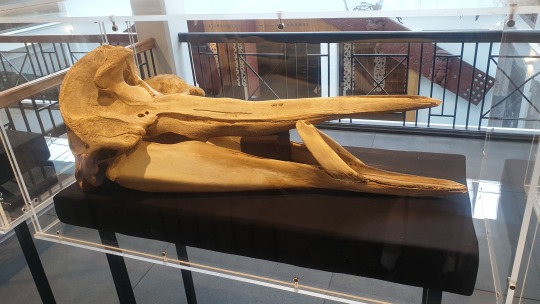
Named after the bizarre teeth, and Edgar Leopold Layard, the curator of the South African Museum, who sent drawings of a skull to the British taxonomist John Edward Gray, who described the species in 1865.
Largest of the Mesoplodons, growing to 6.2m in length, despite the fact that the strap-like tusks stop them opening their jaws more than 3cm. At least the females aren't so encumbered. It seems certain the teeth are used in male-male combat, but the only actual damage comes from a small spike on the tip of the teeth.
Sporadic strandings and sightings suggest the whale is widespread in the Southern Ocean, although one individual did show up in Myanmar in 2011.
Mostly a squid-feeder, caught by suction feeding. Hunted by orca, and harmed by sonar.
Whanganui Regional Museum, New Zealand
#mesoplodon#ziphiidae#beaked whale#strap-toothed beaked whale#tw: dead animal#cetacean#strap-toothed whale
48 notes
·
View notes
Text


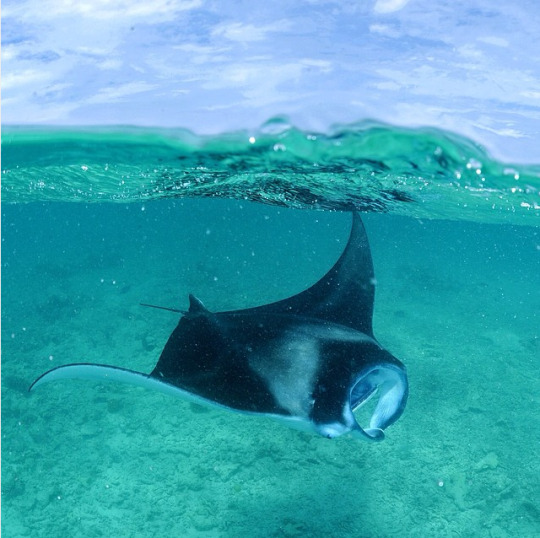
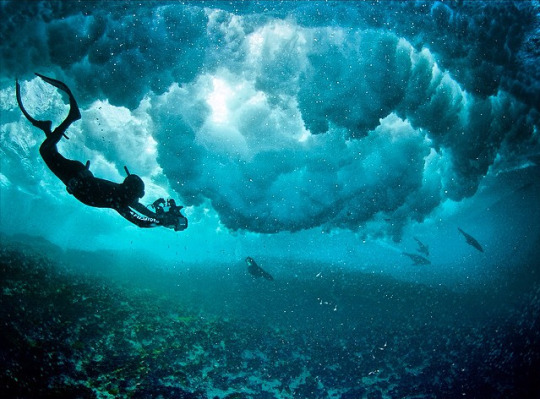
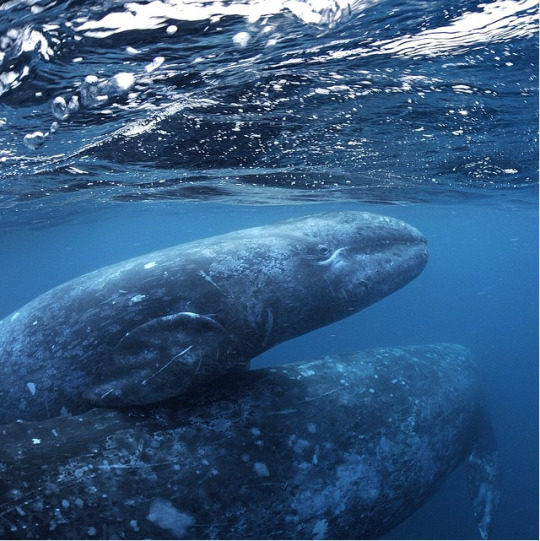
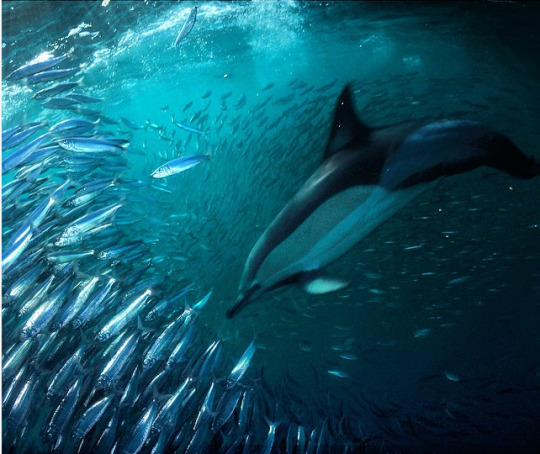

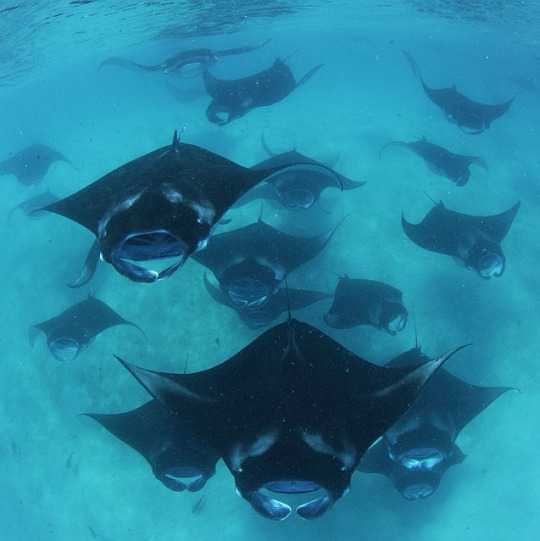
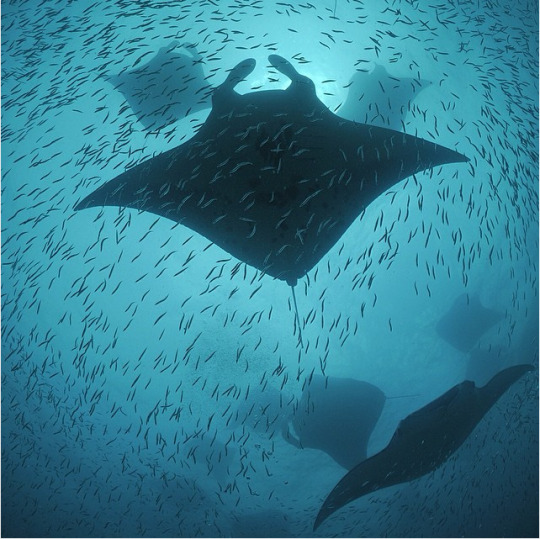
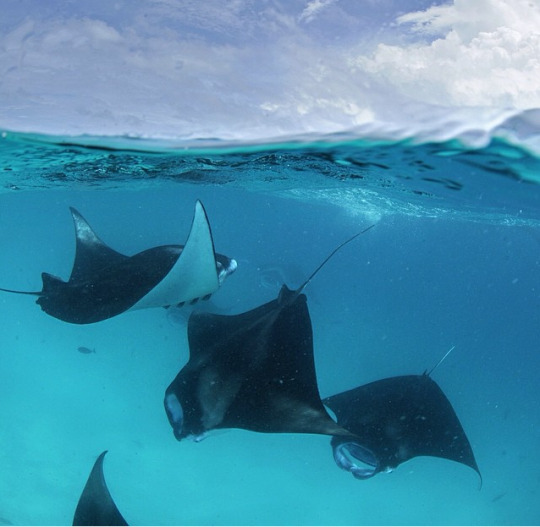

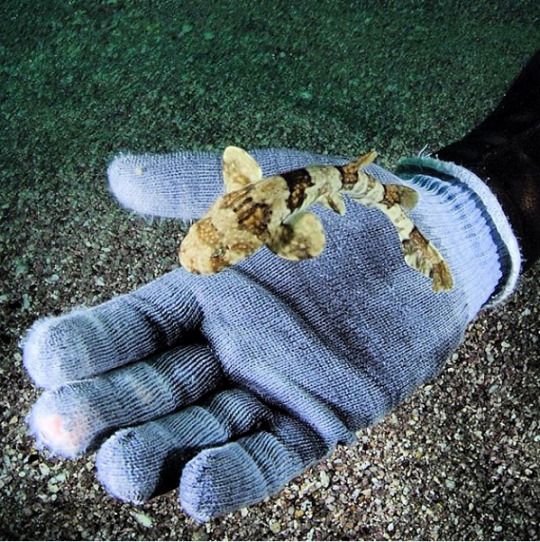
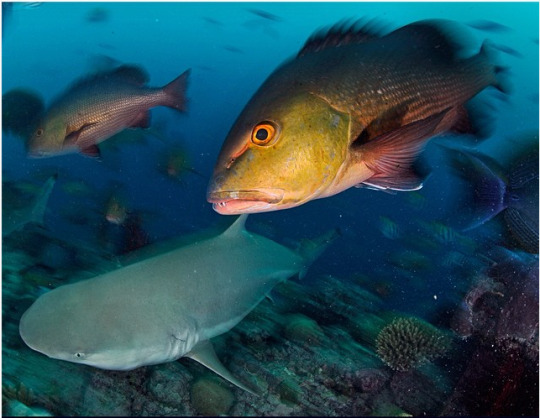
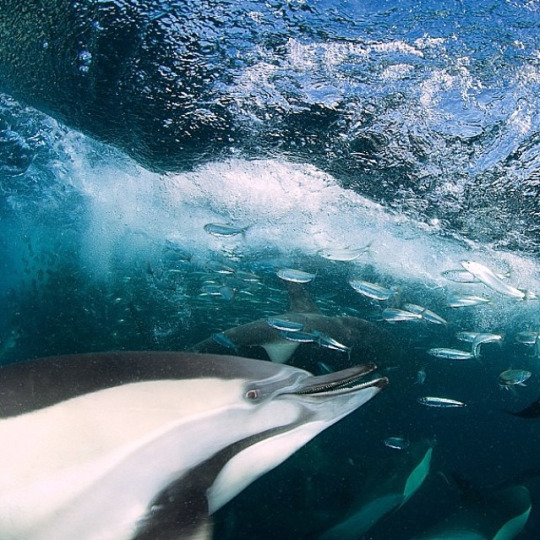
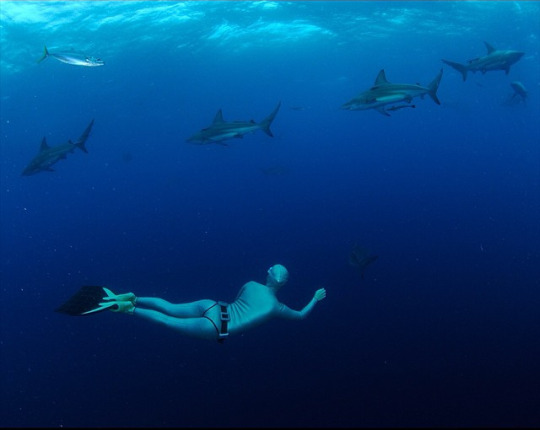
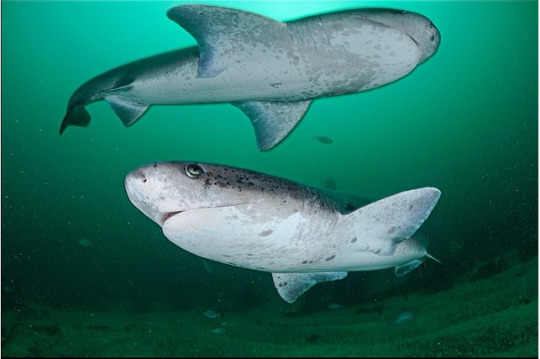
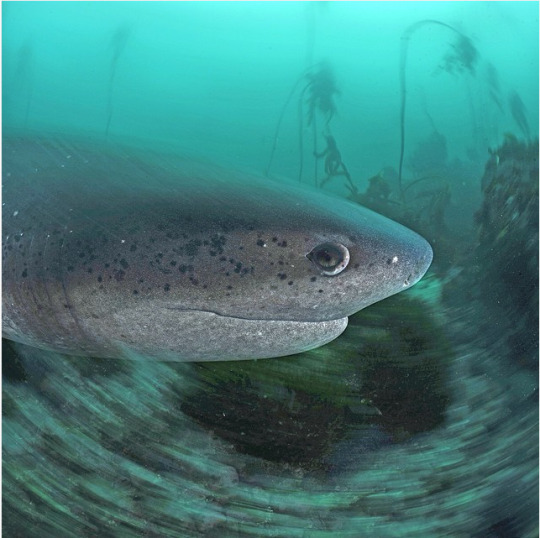

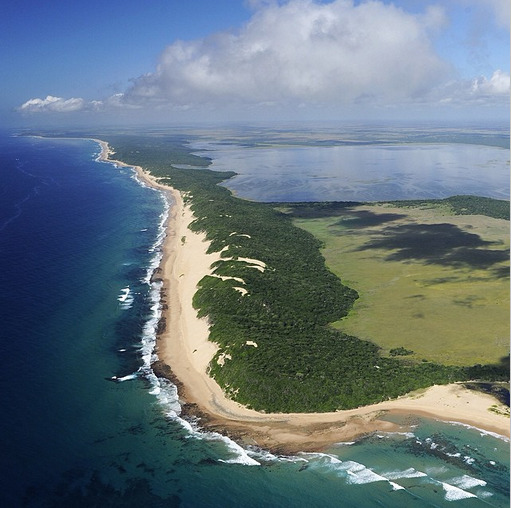
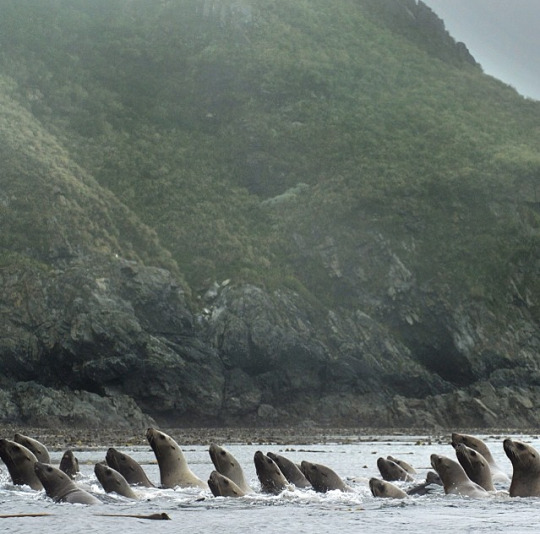
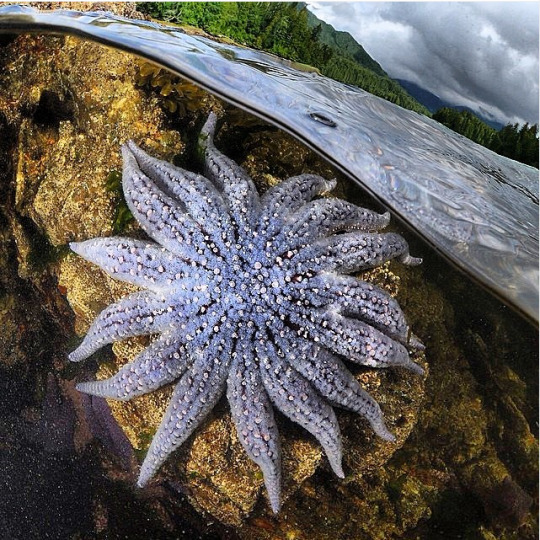
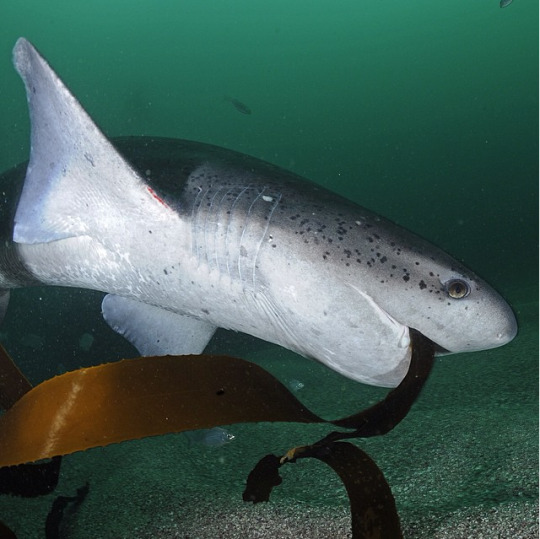
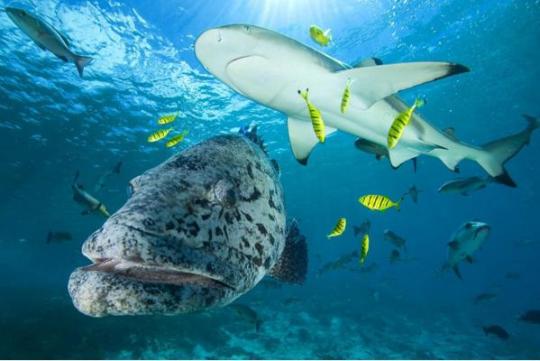
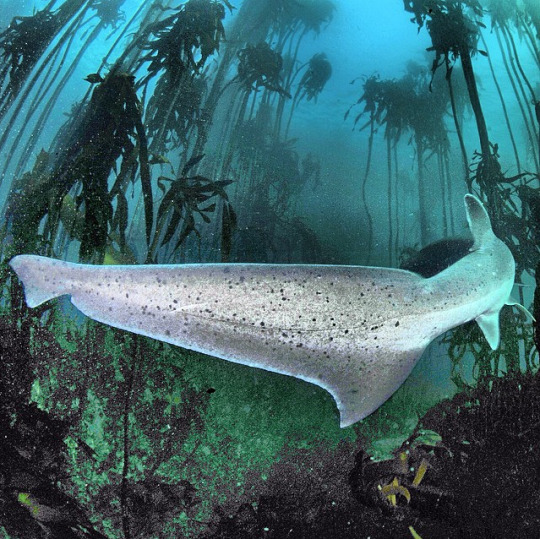
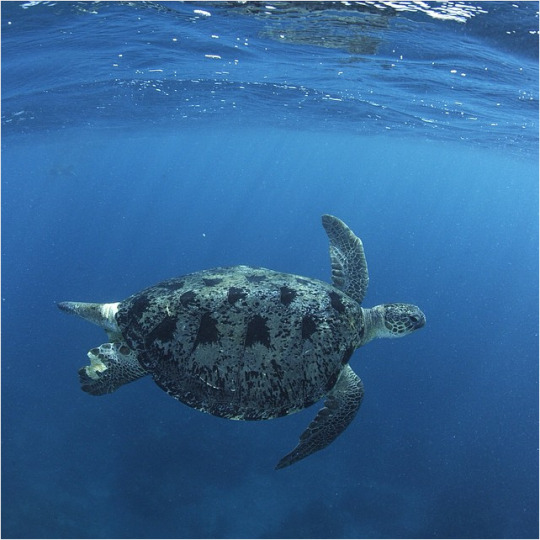
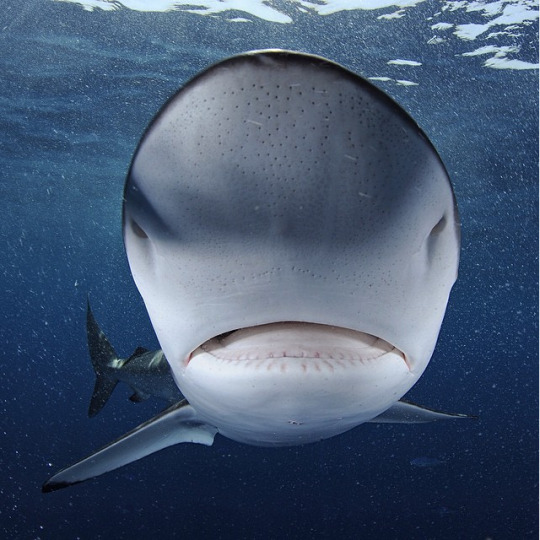



Photos and text: @thomaspeschak
1-. A blacktip reef shark navigates a narrow canyon off Aldabra Atoll. Seychelles
2-. Every winter sub-adult whale shark gather in the seas off Djibouti
3-. Hanifaru Bay in the Maldives
4-. I had been watching these seals for years & wanted to photograph them surfing a unique underwater perspective on southern African marine reserves
5-. In Mexico's San Ignacio lagoon a gray whale mother pushes it's young calf to the surface so it can get a better look at the photographer
6-. June-July is sardine run time off South Africa's East Coast. Long-beaked common dolphins are the only predators that hunt cooperatively
7-. Kira is a black labrator that loves swimming with dolphins
8-. Manta rays. Hanifaru Bay in the Maldives
9-. Mantas feeding amongst baifsish. Hanifaru Bay
10-. Reef mantas feeding at Hanifaru Marine Reserve
11-. My fascination with seahorses began more than 10 years ago when I still was a graduate student in marine biology
12-. Not all sharks look like Jaws. An endemic Puffader shy shark hovers above dive guide hand
13-. Sharks, Bohar snapper and other predatory fish are abundant on the fringing coral reefs of the seas around D'Arros Island and St. Joseph Atoll, Seychelles
14-. Long beaked common dolphin hunting sardines off South Africa's Wild Coast
15-. South African free diver @hanlinprinsloo diving with blacktip sharks in the Aliwal Shoal Marine Protected Area
16-. y 17-. South Africa's Table Mountain Marine Protected Area host a unique sevengil shark aggregation site wich draws divers from all over the world
18-. South Africa's Wild Coast is a mosaic of river mouths, grassy hillsides and formidable sea cliffs
19-. Aerial perspective of the sanctuary zone of the Ponta do Ouro Marine Reserve, Mozambique
20-. Steller's sea lions ar common off Canada's British Colomia coast where populations of their preferred prey such a sand lance and herring are still relatively abundant
21-. Sunflower sea stars are the largest shallow water starfish in the world
22-. The broadnosed sevengill shark is a top predator in South Africa's kelp forests. With saw shaped teeth akin to tiger sharks, they hunt fish and scavenge dead fur seals
23-. The seas around Aldabra atoll are some of the most pristine in the Seychelles and the entire western Indian Ocean
24-. The tail belongs to one of the top predators in South Africa's kelp forest
25-. This green turtle traverses the unbelievably blue waters of Europa Atoll in search of a mate
26-. To survive in the vastness of the open ocean, Silky sharks rely on their boldness and curiosity to investigate every opportunity that might yield a meal
27-. y 28-. This pod of Indo-Pacific Bottlenose dolphins regularly crosses from Mozambican into South African waters
12 notes
·
View notes
Text
Design Differences:
First, I'll discuss the variations in dragon designs, which can be influenced by factors such as gender, race, and status.
Gender differences in design can vary depending on race, but there are general factors that distinguish males from females across most races. The primary distinction lies in their scales and fur. Male Hylian and Zonai Dragons have fur instead of scales, except for the scales near their spines. On the contrary, Gerudo Dragons always have scales, even if they are male, due to the female-dominant nature of their race. Gorons are similar to the hylians but instead of fur, the males have lava scales. It's worth noting that the Rito have feathers, so this rule doesn't apply to them. Another key gender difference if female Dragons are always larger than males from their own race. This results in a significant size difference between the two genders. Additionally, females will have more clublike tails with spikes, while males will have straight, pointed tails without the extra spikes. This distinction, again, does not apply to the Gerudo.
The six races of Hyrule each have distinctive characteristics that make them unique.

For example, the Hylians, the smallest dragon type, are known for their long triangular snouts with long eyelashes. They have extra smooth fur that matches their hair color on their necks, animalistic horns, and crystallized spines. Their scales or fur typically range from tan to gray and their underbelly is darker than that of most other races.

The next biggest dragon is the Rito. They have long and eloquent tails, with feathers covering their body instead of fur or scales. Their six pairs of talons are the most bird-like out of all the races. Additionally, they have small feathery wings attached to each limb that aid in maneuvering through the air. Extra feathers on their head and neck provide additional warmth, and they also have a small beak on their snout. Feathers adorn the end of their tail, and their coloring can range from blue to pink to gray to white, typically matching their previous coloration.

Next up is the Goron race. They are medium-sized and have rock-like features of various shapes and sizes on their head instead of horns. They have big circular eyes and their square snouts are very sweet and gentle despite their appearance. Additionally, they have rock-like spines running down their backs, which differ in appearance. The Gorons' bodies are either made of stone scales or lava, giving them distinct appearances depending on their gender. In both genders, their limbs are stone-like, and their tails are typically very thick.

The Zonai, who are not much bigger than the Gorons, are quite animalistic, with short curved snouts and big long ears resembling a goat. They also have quite goat-like horns and soft, bulky fur running down their necks. Their limbs are also quite long compared to most of the other races. The spikes going down their back resemble fur and even feel soft. Also one thing to keep in mind is that the zonai dragons are different from the goddess dragons. I will cover that more in the three goddesses.
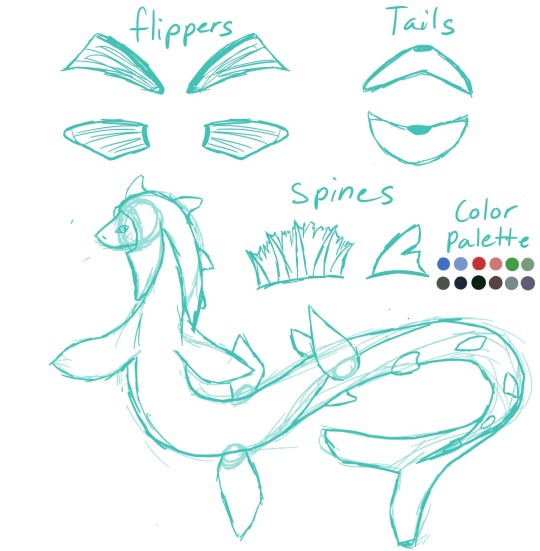
The Zora, being the aquatic race, possess unique underwater adaptations that set them apart from other races. Unlike the Highlands, they lack fur on their necks; instead, their necks extend into whale or fish-like fins. They have gills for breathing underwater, as they spend most of their time there. Their spines resemble shark or fish fins, sometimes with membrane-like structures between the spines. Their tails will fan out, resembling various fish or shark tails. Their fins, replacing talons, and tan or gray underbelly further distinguish them, and they notably lack horns. Their color will match the color they were before the dragonification process.

The largest dragon race is the Gerudo, known for their bulky, pointed snouts, big eyes, and horned heads resembling sharp vines with thorns. They also have fur running down their necks and their scales typically feel sandy and rough. The Gerudo tribe shares similarities with the Hylians, as they are both people, and their spines exhibit distinct features. A difference, though, is the Gerudo tribe’s tails fan out with lots of fur.
This concludes the design portion. You can click here to view the other sections.
#legend of zelda#zelda fanart#zelda#dragon art#dragon link#loz link#dragon#dragonification#totk#design#hylian#rito#goron#zonai#zora#gerudo
8 notes
·
View notes
Text
Trust
Sequel to: Stargazing
Next: chapter 7

Evan walked through the forest, he sighed as he made sure his bag was fully closed. The last thing he needed was anything falling out, he walked further up the path. ‘’Okay maybe I should get a map next time..’’ the deer witch muttered as he kept walking, however he soon stopped as he spotted The Owl House. He quickly pulled his hood down before going to the door, he noticed Hooty was stretched out. The boy wondered if he should be thankful or not that the demon worm wasn't here to give a welcome greeting.
He honestly debated going through the back door, he really didn't want to deal with Hooty. Soon Evan found himself walking to the backdoor kitchen area, although once he found himself passing the window, he could spot Willow and Gus, as well as Hooty…Well, he supposed he was gonna bump into the demon worm sooner or later. He could also spot two pailsmans through the window.
The one near Willow was a golden yellow color, having pale yellow fur around their neck. Along with a wide brown stripe along their abdomen, they even had translucent blue wings, black eyes with yellow sclera, a gray-beak like nose and a pale-yellow stinger. The one next to Gus was a blue color with small golden horns and two ridges on their head, however they had a ridge in the center of their head that looked split. light blue eyes with dark pale yellow irises, a light green stripe under their belly that looked like it extended to their tail.
Honestly they looked adorable, perhaps Evan could ask Willow and Gus about them, like their names and what they were like. Although Evan's thoughts were halted as he heard Gus and Hooty’s voices.
‘’Hooty, we're not gonna make Luz listen to 24 hours of whale noises. What even is a whale? It looks terrifying!’’
‘’Well, I never heard of underground Korean hip-hop before.’’
‘’It’s human music and it's soothing-’’
Evan opened the door, causing both Hooty and Gus to turn their head towards him. Evan's ears went down, ‘’Oh uh, am I interrupting?’’ Evan asked, tilting his head at them. Gus shook his head, ‘’Actually, you came at the perfect time.’’ Evan blinked, now giving an even more confused look. ‘’I did…?’’
‘’Ya, me and Hooty can't decide what could help Luz feel better with her common mold.’’ Hooty huffed, ‘’All I'm saying is whale sounds are VERY comforting.’’ Gus rolled his eyes, ‘’and as I SAID BEFORE whales look terrifying and probably sound terrifying.’’ Evan rubbed the back of his neck, ‘’Well, can't say I really know since I never heard any of them.’’
Finally a frustrated sigh was heard from Willow as she turned to the three. ‘’guys, can we please not stress Evan out over something so small? Besides I have a much better suggestion.’’
The three stood in silence staring at Willow, now curiosity written on their faces, waiting for Willow to speak. Finally Willow spoke, ‘’What if we play them at the same time?’’ she asked, causing both Gus and Hooty to turn to each other with glee, smiles showing on their faces as a loud ‘’oooo!’’ was heard. Evan meanwhile raised an eyebrow, ‘’Are we sure that's a good idea?’’ Willow shrugged, ‘’I don't see the harm in it, after all it could make some really good music.’’ Gus nodded, ‘’Ya come on Evan, it could be fun.’’
Evan shrugged, ‘’I mean…sure why not?’’ He smiled softly before finding a seat and sitting down, before placing his bag on the table. Gus stared at the bag curious, ‘’What’s in the bag?’’ the younger witch asked, pointing at the light lavender bag that Evan had brought with him. Evan gently pat the bag as he spoke, ‘’Well, stuff that helps with common mold, heard that it can make you dizzy and all, so I picked up a few plants here and there for some medicine.’’
As Willow made her way over to the three, she looked at Evan with a puzzled expression before sitting down. ‘’How did you already know about Luz’s common mold before you got here?’’
‘’Oh, the plants told me.’’
An awkward silence filled the room as Hooty, Gus and Willow stared at Evan, as if he had grown a second head. Finally Gus spoke, ‘’You….can talk to plants?’’ he asked as Evan blinked. ‘’Do….Do witches with plant magic not talk to plants?’’ he asked, his ears down now, Willow shook her head in response. ‘’not necessary.’’ Evan looked down at the table, now already feeling embarrassed. ‘Titan I sound like a crazy person..’ the deer witch thought to himself, before feeling a hand on his arm, causing him to look up and spot Gus, who was putting a comforting hand on Evan's arm. ‘’Hey we didn't mean to sound judgemental, we're just surprised that's all.’’ Gus gave a reassuring smile,
‘’I never heard of any witches being able to talk to plants before!’’ Hooty tilted his head, ‘’Although THIS makes me wonder,’’ Hooty felt himself get closer to Evan. Having his forehead touching Evan’s as he stared into his eyes. ‘’Are you a demon or witch?’’ Evan blinked, ‘’uhhh…I'm pretty sure I'm a witch?.......’’
Hooty squinted his eyes, before pulling back and smiling. ‘’Well, whatever you are, you're an interesting witch or demon to say the least!’’ Evan gave a nervous chuckle. ‘’Hahaha….’’ Willow thought for a moment, ‘’Well I apologize if we upset you.’’ Evan shook his head, ‘’oh no, it's fine, I'm not upset or anything it's probably understandable you be surprised! I guess I should've mentioned it when we met.’’ he chuckled, before turning his eyes to the cassette player. ‘’so about the music mixing…’’ Willow gently picked up the two CDs, before placing them both inside the cassette player. She pulled out some headphones. The group placed the headphones on their head, except Evan who seemed to be having trouble with even placing them on his ears.
‘’you need a bit of help there…?’’ Evan shook his head, ‘’No, I got it Willow, if I can just…’’ Evan gently bent the headphones back, just enough to reach his ears. It looked rather awkward to say the least, he definitely had to at least hold them to make sure they didn't fall off. ‘’Okay! Got it.’’ Evan smiled, rather proud he managed to slide the headphones on. Gus pressed play on the cassette player, the sounds of what Evan could assume were whale noises and the underground Korean hip-hop song began to play. Evan almost felt his ears ring from the sound, it…it was a sound alright, Gus, Hooty and Willow meanwhile were seemingly enjoying the sounds being mixed together.
After 20 minutes Gus hit stopped, grinning ever so slightly. ‘’that was definitely interesting alright.’’ Hooty nodded, ‘’Ya! I wonder what other sounds we could mix together!’’ Evan gently slid off the headphones, ‘’Well I should probably check on Luz.’’ Evan got up, putting the bag around him again. ‘’You guys continue to mix some of those while I'm upstairs.’’ Evan walked to one of the cabinets before grabbing a bowl and spoon. ‘’Alright Evan, please be careful not to get common mold.’’ Willow warned, giving the deer witch a concern look, Evan just gave a small smile. ‘’I’ll be fine, not like I've dealt with sickness before.’’
Evan walked up the stairs, the floorboards quietly creaking as he did, his footsteps were quiet. As Evan kept walking he once again felt his mind wonder again. He hadn't been here for a bit, being busy with other things, but he wondered just how much he missed. Soon Evan found himself in front of the door of the guest room, he opened the door as he did he spotted Luz with an echo mouse on her chest, muttering in a little singing voice. ‘’Little mouse, Owl House, frilly blouse.’’ She was gently playing with the small creature’s ears. Evan walked over, ‘’heyy Luz, how are you feeling buddy?’’ He asked, taking a seat next to Luz, who looked at him. ‘’Hey Evan..when did youuu get here?’’ she asked, with a goofy small smile on her face. ‘’About a few minutes ago actually? I heard you had the common mold so I brought a few plants.’’
Evan sat his bag down, before opening it, taking a couple of plants out as well as a jar filled with pinkish liquid. ‘’You make medicine?’’ She asked, staring at him curious. ‘’Sorta…’’ Evan gently took some of the pinkish liquid, placing it in a bowl before grabbing and crushing up some plants. Stirring the liquid together, ‘’When I was smaller, I studied a few plants here and there, my dad-...’’ Evan suddenly became ever so quiet, before he continued to stir the pinkish liquid and plant in the bowl to a cyan greenish color. Luz stared at Evan, worry on her face clearly evident. ‘’Evan did something happen to your-’’
Evan shook his head, ‘’No, he's fine.’’ Evan took a deep breath. ‘’everything is fine, both of my parents are fine.’’ Evan looked away before handing the bowl to Luz. ‘’Look I…I didn't mean to sound rude…just been stressed is all..’’ Luz gave a soft frown, looking at him. ‘’Evan, if you need someone to talk to me and Eda are here-’’
‘’I said I'm fine.’’ Evan snapped, gently putting his bag back on, ears down. ‘’Look just….take your medicine okay?’’ Evan walked out of the room, closing the door behind him. Once the door was closed Evan found himself staring at the ground, before facepalming. He knew Luz was just worried, so why did he snap? Why did he push her away? ‘’I’m so stupid…’’ He muttered, slowly he walked to the wall in front of him before gently hitting his head on the wall. ‘’Stupid, stupid…’’ he softly sighs.
‘You know you can't just push them away..’’ the deer witch thought to himself, ‘you’re gonna have to open up to them about what happened eventually...'
Silence, all there was, was silence. Nothing but Evan's thoughts, he felt pathetic, he hated standing there, head leaning on the wall. He wondered why he couldn't just tell them, why exactly was it so hard for him to just-
Evan covered his ears, taking a few breaths. His heart was thumping out of his chest, it felt like his lungs were closing. Why did it feel so hard to breathe? His entire body felt like it was shaking. He could hear THEM screaming.
The horrible screaming, ‘’shutupshutupshutupshutupshutupshutupshutup.’’
Evan begged, slowly feeling as if he was folding like a stack of cards, his knees met the ground, before his elbows followed soon after. ‘’Please, please, make it stop.’’ he felt himself gripping his ears as he curled up, seemingly in a ball. His breathing felt out of control, it felt like he was drowning, trying to get oxygen that refused to come to his lungs.
He hated it, he wanted it all to stop, he tried to take small breaths, trying to desperately keep his breathing under control. Evan felt his eyes dart around the room, spotting a few items and naming them. Slowly he felt his breathing come to a slow, as he started taking smaller breaths, his heartrate calming down, his lungs relaxing.
Everything was fine, he was fine, everything was okay. Evan looked at the door to where Luz was, he definitely should apologize for how he acted. He walked over to the door, opening only to be greeted by glass cracking, causing Evan to immediately swing the door open, seeing the knocked over broken crystal ball. ‘’Dang it!’’ was heard from Luz as she tried getting up, ‘’Luz?! Titan what happened? Why are you trying to get up?’’ Evan immediately went over to her, before gently placing her back on the mattress. ‘’Need to warn Eda, Amity and King!’’ Luz yelled, Evan's ears went up. ‘’Whoa slow down, just take a few deep breaths and tell me what happened.’’
Luz took a couple of small breaths, trying to find her wording as she did. '’Eda, Amity and King went to get some Titan Blood for a key at Eclipse Lake! A-and they might discover Fool’s Blood and get killed!’’ Luz managed to explain as Evan's ears went up. ‘’Titan’s Blood?? Why do you need it for a key?’’ Evan asked, now even more confused with what was happening. ‘’I’ll explain later, I just need to get up and warn them!’’ Luz was about to attempt to get up again before Evan managed to stop her by putting both his hands on her shoulders and laying her back down. ‘’Luz, you can not go in your state!’’ Evan objected, ears down, worry clearly on his face. ‘’Look, how about I go and tell them okay? I don't want you getting anymore sick then you already are okay?’’ Luz looks down, before sighing. ‘’Alright, hold on let me just-’’ Luz grabbed a piece of paper before scribbling down something and handing it to Evan. He looked at it, gently taking it before placing it in his bag, ‘’Thanks,’’ Evan stood up before stopping and looking back. ‘’Hey Luz, I'm…sorry about earlier..’’ and with that Evan left the room.
As soon as Luz was left alone, she managed to spot her little game device, an idea popping in her head before she snatched it. She started typing on it, sending a few messages to Amity’s game device, mainly Incase Evan did get lost. She really hoped Amity and the others were okay.
…….
Okay, maybe Evan couldn't understand the map, he stared at it, trying to figure out which path he was actually taking, he began to wonder if he had accidentally gotten lost by accident. He kept walking, making sure to avoid any coven scouts that were probably portalling the forest. Thankfully, none seemed to actually be patrolling.
‘’Okay on Evan, this is the least you can do to make up with how you snapped at Luz, dang it!’’ He scolded himself. He looked up at the sky, noticing how dark it had gotten. How long had he been walking for? Hours? Ya it definitely was hours, Almost immediately concern filled Evan as he started to let his imagination take over at what kind of danger the others could be in.
As he let his mind just wander off, he didn't pay attention to where he was going before immediately bumping into someone, Evan yelped looking up as he did. ‘’huh?’’ he spotted,..... Eda? She definitely looked different alright, she had long dark gray hair, even having tufts of hair coming out of her elongated ears. She turned to Evan, her wings gently flapping, her black sclera yellow eyes staring at him.
He raised a hand up, opening his mouth as he tried to process what he was exactly seeing. ‘’Are…..are you a harpy?’’ he asked, Eda picked up a vole before swallowing it, and nodding. As she spoke her voice sounded off, as if she had multiple voices speaking at once. ‘’oh right you weren't here for that were you?’’ She said with a chuckle, as she gave a grin. Evan shook his head, ‘’Big Ears, What are you doing out here?’’ King asked waddling up to Evan, Evan gave a soft sigh, ‘’Well I actually came to warn you about…Fool’s Blood? Ya I'm still kinda lost here and I need someone to explain to me what's happening.’’ Evan fixed his glasses, as he softly sighs. Gently rubbing the back of his head, still trying to process everything. He then heard another voice one he didn't recognize, ‘’Wait you know Luz?’’ Evan looked over, spotting a thin witch with pale skin, bright golden eyes. Her hair was shorten above her shoulders, lavender in color with brown on the undercuts at her temples.
Realization suddenly hit Evan ‘’Hey wait a minute, you're the youngest Blight, and ya I know Luz, we been friends for a bit.’’ Amity raised a eyebrow at him, ‘’You heard of my family?’’ Evan nodded, ‘’I mean your families abomination invention ads are everywhere.’’ King then spoke up, ‘’as for what happened, Eda had a whole owl beast thing and made peace with it and now we got well, that.’’ King pointed to Eda who had managed to grab another vole before snacking on it, causing Evan to shudder ever so slightly. ‘’So you're not aware about Luz being stuck here?’’ Amity asked, as Evan shook his head. ‘’No, of course not. I don't think she ever told me.’’
‘’Well, she needs Titan Blood to make a portal to get back home.’’ Amity explained, Evan gave a surprise look, before holding the front of his head, ‘’Titan, I've missed a lot huh?’’ he sighed, before looking at the ground, ears down. ‘’So where's the key?’’ Amity gave a soft sigh, ‘’Well, we HAD the key, but the Golden Guard-’’
Evan’s ears went immediately up, his full attention on Amity as soon as she said those words. ‘’The Golden Guard? What did he do?’’ Amity’s eyes widen in slight surprise, ‘’You also KNOW the Golden Guard too?’’ Evan rubbed the back of his neck before looking away, ‘’It’s complicated but sorta?’’
Amity gave a frown, ‘’You shouldn't be around him, he's dangerous.’’ she warned, as Evan's brows furrowed a small bit. He shook his head, ‘’But he hasn't done anything harmful from what I know of, surely there must've to have been a misunderstanding right?’’
Finally Eda spoke up, ‘’Evan, the kid's right from what I was told, he started attacking Amtiy and King, trying to get the key. And well, threatening Luz’’ Evan’s eyes immediately widened, ‘’He what?! But he, I-’’ Eda placed a hand on his shoulder, ‘’Kid, there is a likely chance he is manipulating you, you have to be careful around people like The Golden Guard.’’ Evan looked down, ‘’I…I understand Eda..’’
Eda then flew up, gently picking up King and Amity as she did ‘’Come on, we should head back.’’ she held out her hand for Evan, who gently took it without a second thought.
Thoughts ran through Evan's mind as Eda flew to The Owl House, had Hunter truly been manipulating him? Had Hunter been lying to him? Surely Evan would've realized when he was being manipulated, right? However as Evan continued to go deeper into his thoughts, he noticed they landed right in front of The Owl House. Eda gently sat them down, Amity opened the door before entering as the rest followed, well except for Eda who proceeded to get stuck in the doorframe, ‘’Gah, shoot!’’ she muttered, ‘’Kiddos a little help?’’ she asked, trying to push herself through the door. Amity looked over at King and Evan, ‘’okay I'll grab her arm, you grab her hair and other arm.’’ Both King and Evan nodded, before the three started trying to get Eda unstuck.
That's when Luz, Gus, Willow, and Hooty seemed to appear, seemingly hearing Eda trying to get in the house. Honestly Evan lost track of what everyone had been saying, his mind still jumbled with thoughts from earlier. Although Evan snapped out of it when hearing Gus, ‘’Evan where did you head off to? You've been gone for like hours! We were worried dude!’’ Evan's ears went down, as a nervous chuckle escaped him. ‘’Uhh…a emergency came up?’’ However he yelped as him, King, and Amity fell back as Eda managed to pull herself inside. Luz immediately ran over, hugging Amity, ‘’Amity! I'm so glad my awesome girlfriend is okay!’’ Amity felt her face reddening as she hugged Luz back and smiled. ‘’Me too!’’
Evan raised an eyebrow, looking over at Willow and Gus as they nodded, before Evan looked back. ‘’Ya I really need to start catching up with things here…’’ Evan mutters, Gus just gently pat his head, ‘’Don’t be so hard on yourself.’’
King made an annoyed grumble, walking over to Luz and Amity, stomping his foot. ‘’No King hug?!’’ He huffed pointing at Amity with a glare, ‘’You are swindler and a thief!’’ Luz noticing this, felt her mouth become a grin before getting up and scooping up King. ‘’Come here, buddy!’’
King yelped immediately squirming as he did, ‘’I regret this!’’
Evan watched the scene as he chuckled, before his left ear flickered looking over at Amity and Eda, who seemingly were muttering to each other. Evan couldn't make out much what they were saying, but something about how they might be okay.
Evan truly hope so.
#the owl house#toh#the owl house fanart#the owl house oc#the owl house luz#the owl house eda#the owl house king#the owl house amity#the owl house gus#the owl house willow#oc#au
5 notes
·
View notes
Text
Shoebill Bird Characteristics and Identifications


Shoebill Bird Characteristics Shoebill (Balaeniceps rex) The shoebill is a large bird with a prehistoric appearance, often called the "King of the Marsh." It is the only species in its genus. It lives in freshwater wetlands found in East and Central Africa. You can find it primarily in Zambia, South Sudan, and Uganda. Conservation Status Shoebills are vulnerable. Researchers estimate their population to be between 3,300 and 5,300. Their numbers are declining due to habitat loss, hunting, and climate change. Illegal trade also threatens them, as many birds die during capture and transport. Physical Characteristics - Size: Up to 152 cm tall - Weight: 4.9 kg (females), 5.6 kg (males) - Lifespan: Up to 35 years - Beak: Large, shoe-shaped, with sharp edges for hunting. People named shoebills for their distinctive bill, which resembles a Dutch wooden shoe. Their long legs and powerful beak help them catch and kill prey with great effectiveness. They can stand motionless for hours, resembling statues. Habitat & Diet Shoebills like wetlands with slow water. Here, they hunt lungfish, catfish, frogs, snakes, and young crocodiles. They hunt using a method called "collapse hunting." In this technique, they lunge at their prey, using their full body weight. Behavior & Reproduction - Shoebills are solitary birds, maintaining large territories. - They build nests in floating vegetation and lay up to three eggs, but usually only one chick survives. - Both parents care for the eggs and feed the young. - Chicks fledge at around 95 days and become independent at 125 days. Unique Traits - Shoebills communicate through beak-clapping sounds. - Their hunting success rate is around 60%. - They can fly despite their large size, relying on powerful wingbeats. Conservation Efforts Shoebills face threats from habitat destruction, poaching, and climate change. Conservation groups work to protect their wetland habitats and prevent illegal trade. Supporting wildlife organizations helps ensure the survival of this remarkable species. The shoebill is a large, heavy bird, greater in size than a mailbox, standing up to eight feet tall. It is endemic to Central and East Africa. Even when in pairs, shoebills prefer their own space and feed at opposite ends of their territory. The shoebill is unique because of its large, bulbous bill. This bill has many uses. Measuring over 7 inches, it can catch fish. It also makes a clapping sound for hunting and courtship. Males and females have different tones in their "applause." The shoebill was once called a stork or a whale-headed bird. Now, it is part of the Balaenicipitidae family. It looks like herons. It has soft, powdery down feathers on its chest and belly. It flies with its neck pulled back, like pelicans. This might be because it fishes in a similar way. The shoebill is a striking bird with a mix of blue, dark gray, and slate-colored feathers. Its white belly has some decorative feathers on the chest. A small nuchal crest and a ridged bill add to its unique appearance. It is an exceptional hunter, with a powerful bite to catch prey and even separate vegetation. The upper jaw ends in a sharp hook, helping it grip slippery fish. Shoebills can fly well. They take off straight up with a strong jump and fast wingbeats. Their long legs and large feet allow them to move through wetland vegetation with ease.

Shoebill Bird Identifications
Habitat and Behavior
Shoebills live in East Africa's wetlands. They prefer marshes with slow water and plenty of fish. In Uganda, Longumbuls to Lakes Marshy Tree hosts them, where they nest in areas with cane. Their fishing technique, called "slipped," doesn't work well in deep water. So, they like shallow, oxygen-rich waters where fish come to the surface more often. Shoebills avoid human contact and rely on stealth to catch prey. Shoebills nest in floating vegetation, using plant materials from their surroundings. They favor deep, dense marsh areas to avoid predators. They mostly stay still during the day. Sometimes, they hunt at night when the moon shines brightly. They remain motionless for long periods, striking prey with lightning speed. Shoebills regulate body temperature through evaporative cooling on their feet, similar to pelicans. Their strong beak helps them hunt. It lets them dive for fish using their whole body weight. They eat lungfish, catfish, tilapia, snakes, and frogs. Sometimes, they also catch aquatic birds or crocodiles. Feeding and hunting Shoebills hold their bills vertically to locate prey through visual observation and sound. When hunting, they shake their heads to clear vegetation before swallowing prey whole. They prefer to hunt alone and can go several days without eating. Reproduction and Nesting Shoebills breed in sync with local water levels, usually during the dry season. They build nests on floating plants or distant islands, tucked away in reeds and papyrus. They maintain and reinforce their nests throughout the breeding season. They lay one to three eggs, with both parents incubating for about 30 days. Eggs turn from blue-white to brown over time. Gray down covers shoebill chicks, and they rely on their parents for food. At first, they receive three meals a day, and this number rises to five or six as they grow. They fledge in 95 days and become independent at 125 days. Conservation The IUCN lists shoebills as "Vulnerable." They estimate the population is between 3,300 and 5,000. Threats include: - Habitat loss from agriculture. - Hunting - Pollution - Invasive species - Climate change Conservation efforts focus on habitat protection and reducing illegal trade. Read the full article
0 notes
Note
one is also a Gray Whale and the other is Cuvier's Beaked Whale and I just realized the Minke is a dwarf Minke (based on the coloring 😔) but idk if you care about that for your tags fsjcjdjf I'm a little obsessed with whales
thank you sina!!! i was unsure if it was a grey whale thank you! :D i care 🫂🐋 i love whales too but i think you're more knowledgeable on this front ^__^
0 notes
Photo
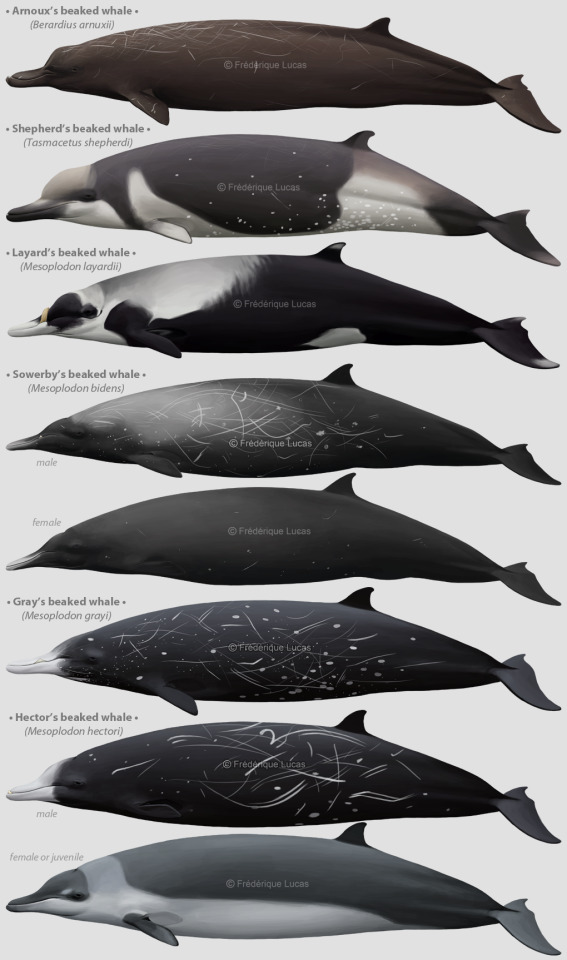
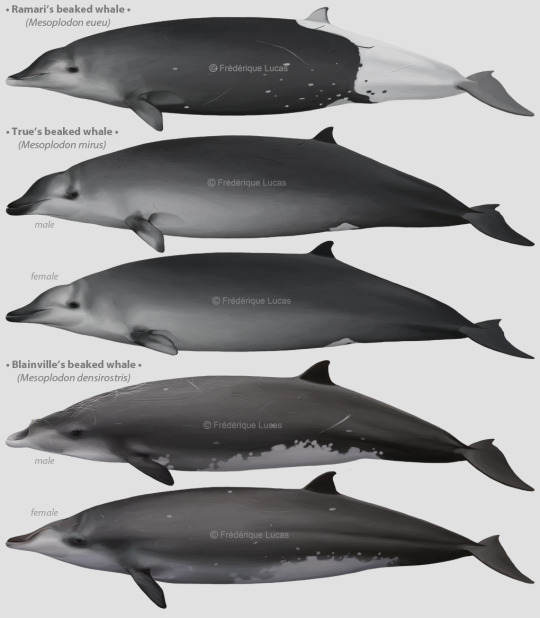
A bunch of beaked whales
I did mention I got to paint a lot of beaked whales, right? ;) After the bottlenose whales here are, well, the others. I thought it was nice to put them all together, really makes you appreciate the wonderful diversity within this big family (and it saves you from ‘a beaked whale a day’ for the next 1.5 weeks). There’s too many to all discuss individually but I have some favourites:
Shepherd’s beaked whale was a joy to paint as they are one of my favourites. Their markings are so beautiful, and they are also unique in being the only beaked whale to have a full set of teeth. For very long their colour pattern was unknown (and oft presumed to have this streaky pattern) until in 2006(!) their real colouration was formally described. They are a beautiful, elegant and unique looking species.
Sowerby’s beaked whale provided a similar ‘aha’ erlebnis for me. Often illustrated as a medium gray throughout (which is certainly fitting for the females) some interesting photographs of adult males showed a rather distinctive light blaze between their blowhole and dorsal fin. In some males it was very subtle, but others had almost as much contrast as a Layard’s beaked whale - I chose to illustrate something in the middle. Very interesting and something I hope will be the subject of further study. Males and females also have funny white lips.
Ramari’s beaked whale can’t be overlooked as it is the youngest member of the family: only described three months ago, in October 2021. Previously known as the southern form of the True’s beaked whale, analysis proved they were a species all of their own. Very happy to have painted this one too, as the mysterious southern True’s with their shining white peduncles always intrigued me.
And lastly, I can’t not mention Blainville’s beaked whale because take a closer look at that snout. Any whale whose mouth somehow ends up above their eyes is worthy of an extra look I think. And the Layard’s beaked whale because they have always been my number 1 favourite beaker.
#illustrations#scientific illustrations#beaked whales#Ziphiidae#beaked whale#Arnoux's beaked whale#Berardius arnuxii#Shepherd's beaked whale#Tasmacetus shepherdi#Layard's beaked whale#Strap-toothed whale#Mesoplodon layardii#Sowerby's beaked whale#Mesoplodon bidens#Gray's beaked whale#Mesoplodon grayi#Hector's beaked whale#Mesoplodon hectori#Ramari's beaked whale#Mesoplodon eueu#new species#True's beaked whale#Mesoplodon mirus#Blainville's beaked whale#Mesoplodon densirostris#digital art
208 notes
·
View notes
Text
Wet Beast Wednesday: Cuvier's beaked whale
Today's Wet Beast Wednesday post is going to be a deeper dive than usual, because this week's post is about the deepest-diving whale. Beaked whales are an elusive and poorly-understood family known for diving to extreme depths. Of the 24 known species, Cuvier's beaked whale is the most well-known. Dive in (get it?) to learn about this cryptic cetacean.
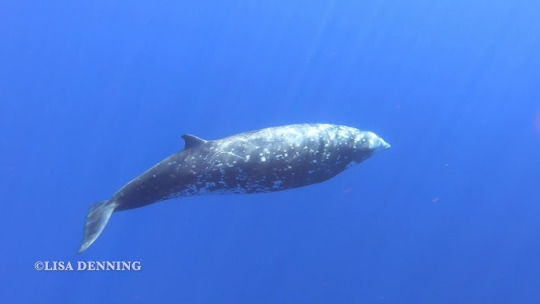
(Image: a Cuvier's beaked whale underwater. It is a small whale similar in appearance to a bottlenose dolphin, though stockier and with a shorter snout. The dorsal fin is far back on the body Its body is gray and covered in white, circular scars, likely bites from cookie cutter sharks. End ID)
Beaked whales are poorly-studied because of their remote habitats and tendency to spend more time underwater than other whales. It is also often hard to distinguish between different species without a close examination. The name comes from their skulls, which are notably toothless and elongated around the mouth, making them look like they have beaks. Beaked whales only have one pair of teeth and they only grow out in males. Female beaked whale teeth remain in the gums and never grow. Cuvier's beaked whale (Ziphius cavirostris), sometimes called the goose-beaked whale, is large for a beaked whale, with the larger males maxing out at 7 meters (23 ft) and 3.5 tons. They resemble dolphins in body shape, but with robust and stocky bodies. Their bodies are gray to light brown while the heads are lighter in color, especially in males. The melon is relatively small and the mouth is shorter than in most beaked whales, making it easier to differentiate them. The melon is an organ found in toothed whales that aids in echolocation.
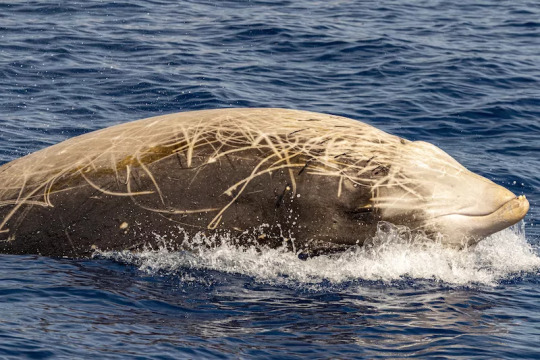
(image: a beaked whale peaking its head out of the water. It is likely a male due to its white face. Its back is densely covered in long, whit scars. End ID)
Beaked whales have multiple adaptations to deep diving. During dives, the heart rate decreases and blood flow is redirected to more important organs and tissues. The lungs collapse, leaving oxygen storage to the hemoglobin in the blood and myoglobin in the muscles. Long periods of time without breathing results in the buildup of lactic acid in the blood, which can be toxic. Beaked whales have enlarged spleens and livers that may help filter lactic acid out of the blood. Their bodies are very streamlined and the flippers can be held very tightly against the body to reduce drag. There are likely other adaptations for very deep and very long dives that have not been studied.
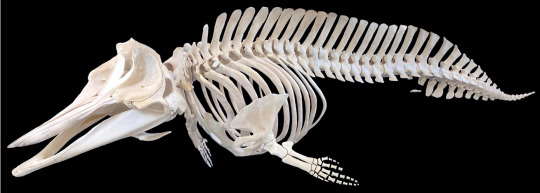
(Image: the skeleton of a Cuvier's beaked whale. It is somewhat short for a whale, with small flippers. The skull is long and flat. End ID)
Cuvier's beaked whale is the most widely-distributed beaked whale, being found worldwide in tropical to temperate waters. They prefer to swim in very deep water and are rarely seen near shore. Cuvier's beaked whale holds the record for the deepest and longest dive of any marine mammal. The records (recorded by satellite tags) for depth was a dive to 2,992 m (9,816 ft) and for length was a 222 minute (about 3.75 hours) dive. The whales will usually make multiple shallower dives to around 500 m (1,640 ft) between each deep dive, possibly to give their bodies time to recover while still searching for food. They spend very little time at the surface between dives, usually no more than 8 minutes. These short surface intervals may be to avoid predators like orcas. Occasionally, longer surface intervals of several hours have been observed. Their hunting behavior changes depending on how deep they dive. On shallower dives, they remain silent, possibly to avoid being overheard by predators, while on deep dives, they use echolocation to find prey in the darkness of the deep ocean. Cuvier's beak whale hunts via suction. They open their mouths while retracting the tongue and enlarging the throat to create a vacuum that sucks prey into their mouths, which is then swallowed whole. Dissections have revealed that squid make up over 80% of their diet. The whales forage in small pods that coordinate their dives and hunting strategy. It has been speculated that the teeth of males are used to fight over access to females. Males have been found with scars that would seem to fit being raked with another male's teeth. Males also generally have more scars than females, which would be consistent with them fighting each other. Almost nothing is known about beaked whale reproduction, though calves do live with their mothers as in other whales.

(Image: a Cuvier's beaked whale jumping out of the water. End ID)
Little is known about the conservation needs of Cuvier's beaked whale. They are likely the most abundant species of beaked whale due to their wide distribution. They are known to be threatened by entanglements in fishing nets and have been harvested by whalers in the past. They may be targeted by the Japanese whaling industry, but it is difficult to be sure due to the secrecy of said industry. Cuvier's beaked whale is known to be vulnerable to sonar, especially mid-range sonar. They have been observed avoiding areas where sonar is used and use of sonar has been correlated to mass strandings and symptoms of decompression sickness (the bends). It is possible that the sonar drives them to ascend from dives too quickly, leading to potentially fatal gas embolisms. Notably, several mass strandings happened in the Canary Islands while naval exercises were performed there. Once those exercises stopped, the mass strandings stopped as well. Cuvier's beaked whale was described and named by naturalist, zoologist, paleontologist, and virulent racist and misogynist Georges Cuvier, who described it using a skull he thought was a fossil. There has been a small push recently to begin using the name goose-beaked whale instead to keep from honoring him.
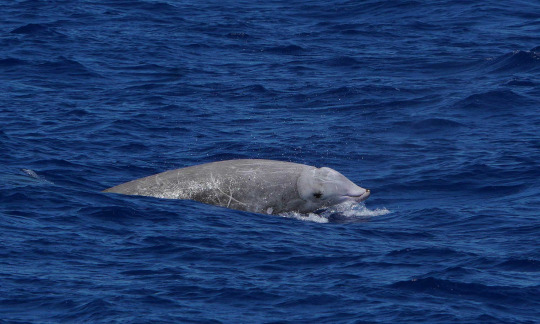
(Image: a Cuvier's beaked whale poking its head out of the water. Its body is light gray, with a few scars. End ID)
#wet beast wednesday#whale wednesday#cuvier's beaked whale#goose-beaked whale#beaked whale#whale#whales#cetacean#toothed whale#marine mammals#marine biology#biology#ecology#zoology#animal facts#informative#educational#image described
51 notes
·
View notes
Text
#2485 - Mesoplodon grayi - Gray's Beaked Whale
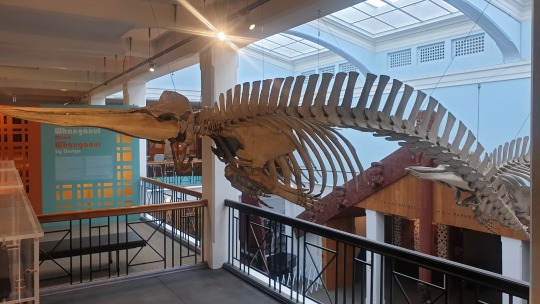
AKA Haast's beaked whale, the scamperdown whale, or the southern beaked whale. In te re Māori hakurā or iheihe.
FIrst described in 1876 by Julius von Haast, director of the Canterbury Museum, in Christchurch, New Zealand. He named it after the British taxonomist John Edward Gray, a zoologist at the British Museum. Gray had already named another whale after the founder of the Colonial Museum in Wellington.
A comparatively well-known member of the genus, found in the Southern Hemisphere between 30 and 45°, and regularly stranded (although one very peculiar stranding was in the Netherlands. God knows what it was doing up there). Pods include up to 28 individuals, judging by the strandings in New Zealand.
Both sexes have small teeth at the rear of the jaw, but males also have a pair of triangular teeth halfway along the jaw that they use in combat with other males, if the scars on males are any evidence. Circular scars are the result of Cookiecutter Shark bites.
Whanganui Regional Museum, New Zealand
1 note
·
View note